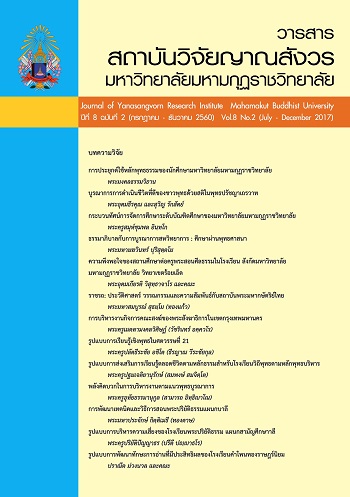INDICATORS OF INTEGRATED LEADERSHIP FOR SECONDARY SCHOOL ADMINISTRATORS UNDER THE OFFICE OF BASIC EDUCATION COMMISSION
Main Article Content
Abstract
The purposes of this study were (1) to develop the indicators of structural relationships model of integrated leadership of school principals under the Office Basic Education Commission, the Ministry of Education, Thailand, and (2) to examine the validity of the model by using empirical data. The 5-point rating scale with the reliability of 0.965 was used in the collecting of data from the 860 school principals who were proportionally stratified random sampled. The descriptive, the referential statistics, and AMOS software were used. Results of the study were as follows: 1. The indicators of integrated leadership of school principals under the Office of Basic Education Commission consisted of 4 major elements, 14 sub-elements, and 50 indicators. The emotional intelligence element consisted of five sub-elements which included : 1) Self-Awareness with three indicators; 2) Empathy with three indicators; and 3) Self-Regulation with three indicators; 4) Self-Motivation with three indicators; 5) Social Skills with three indicators. The Vision Element consisted of three sub-elements: 1) Formulating with three indicators; 2) The Articulating with three indicators; and 3) The Implementing with four indicators. The Teamwork Element consisted of three sub-elements: 1) Career Goals with five indicators; 2) Collaboration with four indicators; and 3) The Role Earned with five indicators. The Creativity Element consisted of 3 Sub-elements: 1) Flexibility with four indicators; 2) Originality with five indicators; 3) Imagination with two indicators. All major indicators were averaged and the coefficient of variation for selection of the model indicated the appropriateness of the structural relationships model of integrated leadership of school principals under the Office of Basic Education Commission. The average value of 50 indicators equaled to or greater than 3.00 and a coefficient distribution of these indicators equaled to or less than 20%. 2. The elements of the model were consistent with empirical data with the Chi - Square ( )value equaled to 8.86, the degrees of freedom (df) equaled to 9, the P-value equaled to 0.45, the goodness of fit index (GFI)was 0.99, the adjusted goodness of fit index (AGFI) was 0.98, and the root mean square error of approximation (RMSEA) was 0.00. The major element value was higher than the set value at 0.50 and all of the sub-element and the indicator values were higher than the set values at 0.30.
Article Details
References
นงลักษณ์ วิรัชชัย. (2551.) “การพัฒนาตัวบ่งชี้การประเมิน” การประชุมวิชาการ เปิดขอบฟ้าคุณธรรมจริยธรรม. วันที่ 29 สิงหาคม 2551. โรงแรมแอมบาสเดอร์
ยาเบ็น เรืองจรูญศรี(2552). การบริหารเชิงบูรณาการ (CEO) สืบค้นวันที่ 15 กรกฏาคม 2557 .เข้าถึงได้จาก www.kroobannok.com/
รักจุฬา ตังตระกูล (2556) .การสร้างภาวะผู้นำอย่างมีคุณค่า.สืบค้นวันที่ 15 กรกฎาคม 2557 เข้าถึงได้จาก www.intrans.co.th
เรมวล นันท์ศุภวัฒน์. (2542) ภาวะผู้นำทางการแพทย์ในองค์การ,เชียงใหม่ : นพบุรีการพิมพ์.
วรวิทย์ จินดาพล.(2553). ภาวะผู้นำ. กรุงเทพฯ : สถาบันราชภัฏสวนสุนันทา.
ศันสนีย์ ชูเชื้อ. (2546). ปัจจัยที่ส่งผลต่อการทำงาน เป็นทีมของพนักงานมหาวิทยาลัยวลัยลักษณ์. วิทยานิพนธ์ บริหารธุรกิจมหาบัณฑิตสาขาการจัดการมหาวิทยาลัยวลัยลักษณ์.
อนันท์ งามสะอาด (2553) “กระบวนการจัดการเรียนรู้เพื่อพัฒนาผู้เรียนอาชีวศึกษา”เข้าถึงได้จาก : http://sisatblog.wordpress.com/2010/08/07/rr/ ค้นคืนข้อมูล 16 มกราคม 2559
Booth, R.Z. (1994). A mandate for nursing education leadership : Change. Journal of Professional Nursing, 10(January-April), 335-341.
Crow, Raym. “The case for institutional repositories: SPARC position paper.” [Online]. Available: http://scholarship.utm.edu/20/1/SPARC_102.pdf 2002.
David Saunders (2002). Integral leadership. สืบค้นวันที่ 15 กรกฏาคม 2557 เข้าถึงได้จากhttp : //en.wikipedia.org/wiki/Integral_leadership
Lynelle Briggs (2005) Co-design with customers is vital to Service Delivery Reform สืบค้นวันที่ 20 กรกฎาคม 2557 เข้าถึงได้จากhttp : //www.humanservices.gov.au/Palus, C.J. & Horth, D.M. (2005). The Leader’s Edge : Six Creative Competencies for Navigating Complex Challenges. San Francisco : Jossey Bass.
Ginny O'Brien(2006). Integrated Strengths Lead to Next Level. สืบค้นวันที่ 20 กรกฎาคม 2557 เข้าถึงได้จาก http : //www.columbiaconsult.com
Rebecca Shambaugh (2013).Leader to Leader Volume 2013, Issue 69, pages 24–30, Summer 2013


